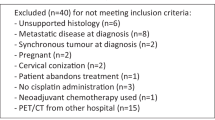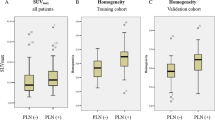Abstract
Purpose
The aim of this pilot study was to explore heterogeneity in the temporal behavior of intratumoral [18F]fluorodeoxyglucose (FDG) accumulation at a regional scale in patients with cervical cancer undergoing chemoradiotherapy.
Methods
Included in the study were 20 patients with FIGO stages IB1 to IVA cervical cancer treated with combined chemoradiotherapy. Patients underwent FDG PET/CT before treatment, during weeks 2 and 4 of treatment, and 12 weeks after completion of therapy. Patients were classified based on response to therapy as showing a complete metabolic response (CMR), a partial metabolic response (PMR), or residual disease and the development of new disease (NEW). Based on the presence of residual primary tumor following therapy, patients were divided into two groups, CMR and PMR/NEW. Temporal profiles of intratumoral FDG heterogeneity as characterized by textural features at a regional scale were assessed and compared with those of the standardized uptake value (SUV) indices (SUVmax and SUVmean) within the context of differentiating response groups.
Results
Textural features at a regional scale with emphasis on characterizing contiguous regions of high uptake in tumors decreased significantly with time (P < 0.001) in the CMR group, while features describing contiguous regions of low uptake along with those measuring the nonuniformity of contiguous isointense regions in tumors exhibited significant temporal changes in the PMR/NEW group (P < 0.03) but showed no persistent trends with time. Both SUV indices showed significant changes during the course of the disease in both patient groups (P < 0.001 for SUVmax and SUVmean in the CMR group; P = 0.0109 and 0.0136, respectively, for SUVmax and SUVmean in the PMR/NEW group), and also decreased at a constant rate in the CMR group and decreased up to the 4th week of treatment and then increased in the PMR/NEW group.
Conclusion
The temporal changes in the heterogeneity of intratumoral FDG distribution characterized at a regional scale using image-based textural features may provide an adjunctive or alternative option for understanding tumor response to chemoradiotherapy and interpreting FDG accumulation dynamics in patients with malignant cervical tumors during the course of the disease.





Similar content being viewed by others
References
Hong JH, Tsai CS, Lai CH, Chang TC, Wang CC, Chou HH, et al. Recurrent squamous cell carcinoma of cervix after definitive radiotherapy. Int J Radiat Oncol Biol Phys. 2004;60(1):249–57.
Waggoner SE. Cervical cancer. Lancet. 2003;361(9376):2217–25.
Bachtiary B, Boutros PC, Pintilie M, Shi W, Bastianutto C, Li JH, et al. Gene expression profiling in cervical cancer: an exploration of intratumor heterogeneity. Clin Cancer Res. 2006;12(19):5632–40.
Davidson SE, West CM, Roberts SA, Hendry JH, Hunter RD. Radiosensitivity testing of primary cervical carcinoma: evaluation of intra- and inter-tumour heterogeneity. Radiother Oncol. 1990;18(4):349–56.
Dehdashti F, Grigsby PW, Lewis JS, Laforest R, Siegel BA, Welch MJ. Assessing tumor hypoxia in cervical cancer by PET with 60Cu-labeled diacetyl-bis(N4-methylthiosemicarbazone). J Nucl Med. 2008;49(2):201–5.
Dehdashti F, Grigsby PW, Mintun MA, Lewis JS, Siegel BA, Welch MJ. Assessing tumor hypoxia in cervical cancer by positron emission tomography with 60Cu-ATSM: relationship to therapeutic response – a preliminary report. Int J Radiat Oncol Biol Phys. 2003;55(5):1233–8.
Delorme S, Knopp MV. Non-invasive vascular imaging: assessing tumour vascularity. Eur Radiol. 1998;8(4):517–27.
Grigsby PW, Watson M, Powell MA, Zhang Z, Rader JS. Gene expression patterns in advanced human cervical cancer. Int J Gynecol Cancer. 2006;16(2):562–7.
Pugachev A, Ruan S, Carlin S, Larson SM, Campa J, Ling CC, et al. Dependence of FDG uptake on tumor microenvironment. Int J Radiat Oncol Biol Phys. 2005;62(2):545–53.
Schwarz JK, Rader JS, Huettner PC, Watson MA, Grigsby PW. Molecular characterization of FDG-PET metabolic response in cervical cancer. Int J Radiat Oncol Biol Phys. 2007;69(3 Suppl 1):S115.
Zhao S, Kuge Y, Mochizuki T, Takahashi T, Nakada K, Sato M, et al. Biologic correlates of intratumoral heterogeneity in 18F-FDG distribution with regional expression of glucose transporters and hexokinase-II in experimental tumor. J Nucl Med. 2005;46(4):675–82.
Eary JF, O’Sullivan F, O’Sullivan J, Conrad EU. Spatial heterogeneity in sarcoma 18F-FDG uptake as a predictor of patient outcome. J Nucl Med. 2008;49(12):1973–9.
Grigsby PW, Siegel BA, Dehdashti F, Rader J, Zoberi I. Posttherapy [18F]fluorodeoxyglucose positron emission tomography in carcinoma of the cervix: response and outcome. J Clin Oncol. 2004;22(11):2167–71.
Hicks RJ, Mac Manus MP, Matthews JP, Hogg A, Binns D, Rischin D, et al. Early FDG-PET imaging after radical radiotherapy for non-small-cell lung cancer: inflammatory changes in normal tissues correlate with tumor response and do not confound therapeutic response evaluation. Int J Radiat Oncol Biol Phys. 2004;60(2):412–8.
Kalff V, Duong C, Drummond EG, Matthews JP, Hicks RJ. Findings on 18F-FDG PET scans after neoadjuvant chemoradiation provides prognostic stratification in patients with locally advanced rectal carcinoma subsequently treated by radical surgery. J Nucl Med. 2006;47(1):14–22.
van Loon J, Offermann C, Ollers M, van Elmpt W, Vegt E, Rahmy A, et al. Early CT and FDG-metabolic tumour volume changes show a significant correlation with survival in stage I-III small cell lung cancer: a hypothesis generating study. Radiother Oncol. 2011;99(2):172–5.
van Stiphout RG, Lammering G, Buijsen J, Janssen MH, Gambacorta MA, Slagmolen P, et al. Development and external validation of a predictive model for pathological complete response of rectal cancer patients including sequential PET-CT imaging. Radiother Oncol. 2011;98(1):126–33.
El Naqa I, Grigsby PW, Apte A, Kidd E, Donnelly E, Khullar D, et al. Exploring feature-based approaches in PET images for predicting cancer treatment outcomes. Pattern Recogn. 2009;42(6):1162–71.
Tixier F, Le Rest CC, Hatt M, Albarghach N, Pradier O, Metges JP, et al. Intratumor heterogeneity characterized by textural features on baseline 18F-FDG PET images predicts response to concomitant radiochemotherapy in esophageal cancer. J Nucl Med. 2011;52(3):369–78.
MacDonald D, Lin L, Wahab S, Esthappan J, Mutic S, Nantz R, et al. Combined IMRT and brachytherapy in the treatment of intact cervical cancer. Int J Radiat Oncol Biol Phys. 2006;66(3):S43.
Schwarz JK, Siegel BA, Dehdashti F, Grigsby PW. Association of posttherapy positron emission tomography with tumor response and survival in cervical carcinoma. JAMA. 2007;298(19):2289–95.
Miller TR, Grigsby PW. Measurement of tumor volume by PET to evaluate prognosis in patients with advanced cervical cancer treated by radiation therapy. Int J Radiat Oncol Biol Phys. 2002;53(2):353–9.
Loh HH, Leu JG, Luo RC. The analysis of natural textures using run length features. IEEE Trans Industrial Electronics. 1988;35(2):323–8.
Thibault G, Fertil B, Navarro C, Pereira S, Cau P, Levy N, et al. Texture indexes and gray level size zone matrix: application to cell nuclei classification. In: Krasnoproshin V, Ablameyko S, Sadykhov R, editors. Proceedings of 10th International Conference on Pattern Recognition and Information Processing; 2009 May 19–21; Minsk, Belarus. Belarus: Belarusian State University; 2009. p. 140–5
Hollander M, Wolfe DA. Nonparametric statistical methods. 2nd ed. Hoboken: Wiley; 1999.
Gibbons JD, Chakraborti S. Nonparametric statistical inference. 5th ed. Boca Raton: Chapman & Hall/CRC Press; 2011.
Geets X, Lee JA, Bol A, Lonneux M, Gregoire V. A gradient-based method for segmenting FDG-PET images: methodology and validation. Eur J Nucl Med Mol Imaging. 2007;34(9):1427–38.
Montgomery DWG, Amira A, Zaidi H. Fully automated segmentation of oncological PET volumes using a combined multiscale and statistical model. Med Phys. 2007;34(2):722–36.
Hatt M, Le Rest C, Descourt P, Dekker A, De Ruysscher D, Oellers M, et al. Accurate automatic delineation of heterogeneous functional volumes in positron emission tomography for oncology applications. Int J Radiat Oncol Biol Phys. 2010;77(1):301–8.
Yang F, Grigsby PW. Delineation of FDG-PET tumors from heterogeneous background using spectral clustering. Eur J Radiol. 2012;81(11):3535–41.
Showalter TN, Miller TR, Huettner P, Rader J, Grigsby PW. 18F-fluorodeoxyglucose - positron emission tomography and pathologic tumor size in early-stage invasive cervical cancer. Int J Gynecol Cancer. 2009;19(8):1412–4.
Acknowledgments
This work was supported in part by the National Cancer Institute grant R01 CA136931.
Author information
Authors and Affiliations
Corresponding author
Rights and permissions
About this article
Cite this article
Yang, F., Thomas, M.A., Dehdashti, F. et al. Temporal analysis of intratumoral metabolic heterogeneity characterized by textural features in cervical cancer. Eur J Nucl Med Mol Imaging 40, 716–727 (2013). https://doi.org/10.1007/s00259-012-2332-4
Received:
Accepted:
Published:
Issue Date:
DOI: https://doi.org/10.1007/s00259-012-2332-4




